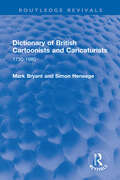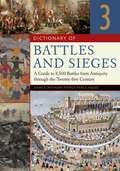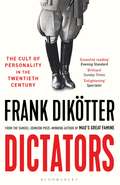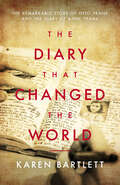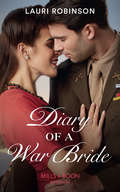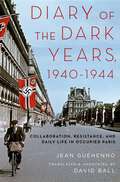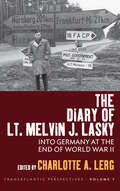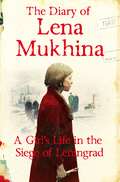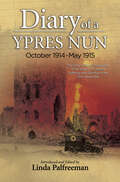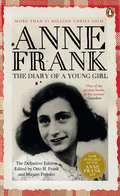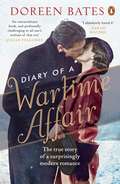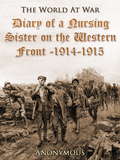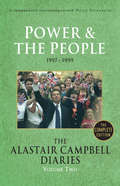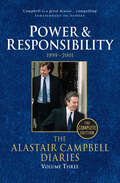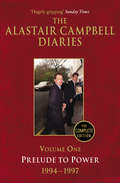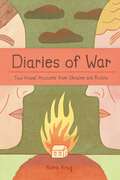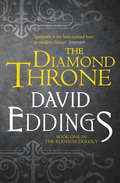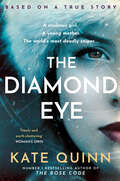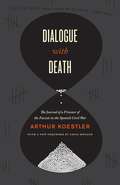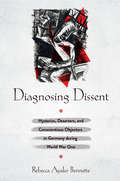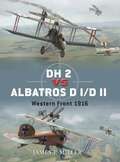- Table View
- List View
Dictionary of British Cartoonists and Caricaturists: 1730-1980 (Routledge Revivals)
by Mark Bryant Simon HeneageOriginally published in 1994, this dictionary provides a unique 'who’s who' of the major figures in the world of British cartoons and caricatures. It was the first book to encompass the entire field from c.1730 when Hogarth published the first of his 'modern moral pictures' to 1980. In addition to describing the careers and achievements of the artists and the characteristics of their styles, more than 500 entries give details of their publications, their illustrations to books and periodicals, exhibitions of their work, public collections in which their work is represented and literature on or referring to them. More than 150 illustrations are included. This is a comprehensive reference work and will be of interest to social and political historians as well as cartoon and caricature enthusiasts.
Dictionary of British Cartoonists and Caricaturists: 1730-1980 (Routledge Revivals)
by Mark Bryant Simon HeneageOriginally published in 1994, this dictionary provides a unique 'who’s who' of the major figures in the world of British cartoons and caricatures. It was the first book to encompass the entire field from c.1730 when Hogarth published the first of his 'modern moral pictures' to 1980. In addition to describing the careers and achievements of the artists and the characteristics of their styles, more than 500 entries give details of their publications, their illustrations to books and periodicals, exhibitions of their work, public collections in which their work is represented and literature on or referring to them. More than 150 illustrations are included. This is a comprehensive reference work and will be of interest to social and political historians as well as cartoon and caricature enthusiasts.
Dictionary of Battles and Sieges [3 volumes]: A Guide to 8,500 Battles from Antiquity through the Twenty-first Century [3 volumes]
by Tony JaquesLead Reviewer: Dr. Daniel Coetzee, Independent Scholar, London, UK Review Board: Jeremy Black, University of Exeter, UK Dr. Frances F. Berdan, Professor of Anthropology, California State University, San Bernardino David A. Graff, Associate Professor, Department of History, Kansas State University Dr. Kevin Jones, University College London Dr. John Laband, Wilfrid Laurier University, Waterloo, Ontario, Canada Dr. Carter Malkasian, Center for Naval Analysis Mr. Toby McLeod, Lecturer in Modern History, University of Birmingham, UK Dr. Tim Moreman, Independent Scholar, London, UK Professor Bill Nasson, Department of Historical Studies, University of Cape Town, South Africa Dr. David Nicolle, Honourary Research Fellow, Nottingham University, UK Dr. Kaushik Roy, Lecturer, Department of History, Presidency College, Kolkata, India Dennis Showalter, Professor of History, Colorado College Dr. Stephen Turnbull, Lecturer in Japanese Religious Studies, Department of Theology and Religious Studies, Leeds University, UK Professor Michael Whitby, Professor of Classics and Ancient History, University of Warwick, UKOver 8,500 battles and sieges are covered-easily the most exhaustive reference source on this basic aspect of military history. Thoroughly vetted by an expert board of period and regional experts, this dictionary offers easy to find A-Z entries that cover conflicts from practically every era and place of human history. In addition to exhaustive coverage of World War II, World War I, the American Civil War, medieval wars, and conflicts during the classical era, this dictionary covers battles fought in pre-modern Africa, the Middle East, Ancient and Medieval India, China, and Japan, and early meso-American warfare as well.Going well beyond the typical greatest or most influential battle format, The Dictionary of Battles and Sieges offers readers information they would be hard-pressed to find anywhere else. Entries were reviewed by area and period experts to ensure accuracy and to provide the broadest coverage possible. Jaques's Dictionary is truly global in scope, covering East Asia, South Asia, Eurasia, Europe, Africa, Mesoamerica, and North and South America. Battles from wars great and small are in the dictionary, including battles from this very brief sampling of wars covered, listed to give an idea of the book's deep coverage: Egyptian-Syrian Wars (1468 BC); the Assyrian Wars (724 - 648 BC); Greco-Persian Wars (498 - 450 BC); the Conquests of Alexander the Great (335-326 BC); Rome's Gallic Wars (121-52 BC); Han Imperial Wars (208); Hun-Ostrogoth Wars (454-68); Sino-Vietnamese Wars (547-605); Mecca-Medina War (624-30); Jinshin War (672); Berber Rebellion (740-61); Viking Raids on, and in, Britain (793-954); Sino-Annamese War (938); Byzantine Military Rebellions (978-89); Afghan Wars of Succession (998-1041); Russian Dynastic Wars (1016-94); Reconquista (1063-1492); Crusader-Muslim Wars (1100- 1179); Swedish Wars of Succession (1160-1210); Conquests of Genghis Khan (1202-27); William Wallace Revolt (1297-1304); Hundred Years War (1337-1453); War of Chioggia (1378-80); Vijayanagar-Bahmani Wars (1367-1406); Ottoman Civil Wars (1413-81); Mongol-Uzbek Wars (1497-1512); German Knights' War (1523); Burmese-Laotian Wars (1574); Cambodian-Spanish War (1599); King Philip's War (1675-77); Franco-Barbary Wars (1728); Bengal War (1763-65); French Revolutionary Wars (1792-1801); Chilean War of Independence (1813-26); Boer-Zulu War (1838); Indian Mutiny (1858-59); Mexican-French War (1862-67); Sino-Japanese War (1894-95); World War I (1914-18); Anhwei-Chihli War (1920); World War II (1939-45) Mau Mau Revolt (1955); 2nd Indo-Pakistani War (1965); Angolan War (1987-88); 2nd Gulf War (2003- ).
Dictators: The Cult of Personality in the Twentieth Century
by Frank DikötterA New Statesman, Financial Times and Economist Book of the Year 'Brilliant' NEW STATESMAN, BOOKS OF THE YEAR'Enlightening and a good read' SPECTATOR'Moving and perceptive' NEW STATESMANMussolini, Hitler, Stalin, Mao Zedong, Kim Il-sung, Ceausescu, Mengistu of Ethiopia and Duvalier of Haiti.No dictator can rule through fear and violence alone. Naked power can be grabbed and held temporarily, but it never suffices in the long term. A tyrant who can compel his own people to acclaim him will last longer. The paradox of the modern dictator is that he must create the illusion of popular support. Throughout the twentieth century, hundreds of millions of people were condemned to enthusiasm, obliged to hail their leaders even as they were herded down the road to serfdom.In How to Be a Dictator, Frank Dikötter returns to eight of the most chillingly effective personality cults of the twentieth century. From carefully choreographed parades to the deliberate cultivation of a shroud of mystery through iron censorship, these dictators ceaselessly worked on their own image and encouraged the population at large to glorify them. At a time when democracy is in retreat, are we seeing a revival of the same techniques among some of today's world leaders?This timely study, told with great narrative verve, examines how a cult takes hold, grows, and sustains itself. It places the cult of personality where it belongs, at the very heart of tyranny.
The Diary That Changed the World: The Remarkable Story of Otto Frank and the Diary of Anne Frank
by Karen Bartlett“A meticulous account of the fascinating, convoluted and sometimes ugly publishing history of the world’s most famous diary. Karen Bartlett’s book is all the more relevant at a time of untruths and fake news.” – Caroline Moorehead, bestselling author of Village of Secrets: Defying the Nazis in Vichy France***When Otto Frank unwrapped his daughter’s diary with trembling hands and began to read the first pages, he discovered a side to Anne that was as much a revelation to him as it would be to the rest of the world.Little did Otto know he was about to create an icon recognised the world over for her bravery, sometimes brutal teenage honesty and determination to see beauty even where its light was most hidden.Nor did he realise that publication would spark a bitter battle that would embroil him in years of legal contest and eventually drive him to a nervous breakdown and a new life in Switzerland. Today, more than seventy-five years after Anne’s death, the diary is at the centre of a multi-million-pound industry, with competing foundations, cultural critics and former friends and relatives fighting for the right to control it.In this insightful and wide-ranging account, Karen Bartlett tells the full story of The Diary of Anne Frank, the highly controversial part it played in twentieth-century history, and its fundamental role in shaping our understanding of the Holocaust.At the same time, she sheds new light on the life and character of Otto Frank, the complex, driven and deeply human figure who lived in the shadows of the terrible events that robbed him of his family, while he painstakingly crafted and controlled his daughter’s story.
Diary Of A War Bride: Marianne's Marriage Of Convenience The Warrior's Runaway Wife Diary Of A War Bride (Mills And Boon Historical Ser.)
by Lauri RobinsonThe land girl and the US Officer July 1942
Diary of the Dark Years, 1940-1944: Collaboration, Resistance, and Daily Life in Occupied Paris
by Jean GuéhennoWinner of the French-American Foundation Translation Prize for Nonfiction Jean Guéhenno's Diary of the Dark Years, 1940-1945 is the most oft-quoted piece of testimony on life in occupied France. A sharply observed record of day-to-day life under Nazi rule in Paris and a bitter commentary on literary life in those years, it has also been called "a remarkable essay on courage and cowardice" (Caroline Moorehead, Wall Street Journal). Here, David Ball provides not only the first English-translation of this important historical document, but also the first ever annotated, corrected edition. Guéhenno was a well-known political and cultural critic, left-wing but not communist, and uncompromisingly anti-fascist. Unlike most French writers during the Occupation, he refused to pen a word for a publishing industry under Nazi control. He expressed his intellectual, moral, and emotional resistance in this diary: his shame at the Vichy government's collaboration with Nazi Germany, his contempt for its falsely patriotic reactionary ideology, his outrage at its anti-Semitism and its vilification of the Republic it had abolished, his horror at its increasingly savage repression and his disgust with his fellow intellectuals who kept on blithely writing about art and culture as if the Occupation did not exist - not to mention those who praised their new masters in prose and poetry. Also a teacher of French literature, he constantly observed the young people he taught, sometimes saddened by their conformism but always passionately trying to inspire them with the values of the French cultural tradition he loved. Guéhenno's diary often includes his own reflections on the great texts he is teaching, instilling them with special meaning in the context of the Occupation. Complete with meticulous notes and a biographical index, Ball's edition of Guéhenno's epic diary offers readers a deeper understanding not only of the diarist's cultural allusions, but also of the dramatic, historic events through which he lived.
Diary of the Dark Years, 1940-1944: Collaboration, Resistance, and Daily Life in Occupied Paris
by Jean GuéhennoWinner of the French-American Foundation Translation Prize for Nonfiction Jean Guéhenno's Diary of the Dark Years, 1940-1945 is the most oft-quoted piece of testimony on life in occupied France. A sharply observed record of day-to-day life under Nazi rule in Paris and a bitter commentary on literary life in those years, it has also been called "a remarkable essay on courage and cowardice" (Caroline Moorehead, Wall Street Journal). Here, David Ball provides not only the first English-translation of this important historical document, but also the first ever annotated, corrected edition. Guéhenno was a well-known political and cultural critic, left-wing but not communist, and uncompromisingly anti-fascist. Unlike most French writers during the Occupation, he refused to pen a word for a publishing industry under Nazi control. He expressed his intellectual, moral, and emotional resistance in this diary: his shame at the Vichy government's collaboration with Nazi Germany, his contempt for its falsely patriotic reactionary ideology, his outrage at its anti-Semitism and its vilification of the Republic it had abolished, his horror at its increasingly savage repression and his disgust with his fellow intellectuals who kept on blithely writing about art and culture as if the Occupation did not exist - not to mention those who praised their new masters in prose and poetry. Also a teacher of French literature, he constantly observed the young people he taught, sometimes saddened by their conformism but always passionately trying to inspire them with the values of the French cultural tradition he loved. Guéhenno's diary often includes his own reflections on the great texts he is teaching, instilling them with special meaning in the context of the Occupation. Complete with meticulous notes and a biographical index, Ball's edition of Guéhenno's epic diary offers readers a deeper understanding not only of the diarist's cultural allusions, but also of the dramatic, historic events through which he lived.
The Diary of Lt. Melvin J. Lasky: Into Germany at the End of World War II (Transatlantic Perspectives #7)
by Charlotte A. Lerg"'The Diary of Lt. Melvin J. Lasky' offers not only a panoramic view of a country poised between devastation and an uncertain future but a gripping self-portrait of a man poised between unresolved youthful bewilderment and a mature clarity of conviction." • Wall Street Journal In 1945 Melvin J. Lasky, serving in one of the first American divisions that entered Germany after the country’s surrender, began documenting the everyday life of a defeated nation. Travelling widely across both Germany and post-war Europe, Lasky’s diary provides a captivating eye-witness account colored by ongoing socio-political debates and his personal background studying Trotskyism. The Diary of Lt. Melvin J. Lasky reproduces the diary’s vivid language as Lasky describes the ideological tensions between the East and West, as well as including critical essays on subjects ranging from Lasky’s life as a transatlantic intellectual, the role of war historians, and the diary as a literary genre.
The Diary of Lt. Melvin J. Lasky: Into Germany at the End of World War II (Transatlantic Perspectives #7)
by Charlotte A. LergIn 1945 Melvin J. Lasky, serving in one of the first American divisions that entered Germany after the country’s surrender, began documenting the everyday life of a defeated nation. Travelling widely across both Germany and post-war Europe, Lasky’s diary provides a captivating eye-witness account colored by ongoing socio-political debates and his personal background studying Trotskyism. The Diary of Lt. Melvin J. Lasky reproduces the diary’s vivid language as Lasky describes the ideological tensions between the East and West, as well as including critical essays on subjects ranging from Lasky’s life as a transatlantic intellectual, the role of war historians, and the diary as a literary genre.
The Diary of Lt. Melvin J. Lasky: Into Germany at the End of World War II (Transatlantic Perspectives #7)
by Charlotte A. Lerg"'The Diary of Lt. Melvin J. Lasky' offers not only a panoramic view of a country poised between devastation and an uncertain future but a gripping self-portrait of a man poised between unresolved youthful bewilderment and a mature clarity of conviction." • Wall Street Journal In 1945 Melvin J. Lasky, serving in one of the first American divisions that entered Germany after the country’s surrender, began documenting the everyday life of a defeated nation. Travelling widely across both Germany and post-war Europe, Lasky’s diary provides a captivating eye-witness account colored by ongoing socio-political debates and his personal background studying Trotskyism. The Diary of Lt. Melvin J. Lasky reproduces the diary’s vivid language as Lasky describes the ideological tensions between the East and West, as well as including critical essays on subjects ranging from Lasky’s life as a transatlantic intellectual, the role of war historians, and the diary as a literary genre.
The Diary of Lena Mukhina: A Girl's Life in the Siege of Leningrad
by Lena MukhinaIn May 1941 Lena Mukhina was an ordinary teenage girl, living in Leningrad, worrying about her homework and whether Vova - the boy she liked - liked her. Like a good Soviet schoolgirl, she was also diligently learning German, the language of Russia's Nazi ally. And she was keeping a diary, in which she recorded her hopes and dreams. Then, on 22 June 1941, Hitler broke his pact with Stalin and declared war on the Soviet Union. All too soon, Leningrad was besieged and life became a living hell. Lena and her family fought to stay alive; their city was starving and its citizens were dying in their hundreds of thousands. From day to dreadful day, Lena records her experiences: the desperate hunt for food, the bitter cold of the Russian winter and the cruel deaths of those she loved. A truly remarkable account of this most terrible era in modern history, The Diary of Lena Mukhina is the vivid first-hand testimony of a courageous young woman struggling simply to survive.
Diary of a Ypres Nun: October 1914-May 1915
by Linda PalfreemanThe Diary of Soeur Marguerite of the Sisters of Lamotte Suffering and Sacrifice in the First World War. The campaign in Flanders, with its successive battles, would be the longest of the Great War and the costliest in terms of human life. At the centre of the fearful and prolonged barrages of shelling by the military of both sides lay the town of Ypres, known for its Cloth Hall and cathedral, its butter and its lace -- now to be blasted to infamy as an indelible symbol of suffering and sacrifice and wanton destruction. The underground passageways of the towns ancient fortifications provided shelter for the trapped townspeople. In desperate circumstances courageous and selfless individuals administered medical attention, distributed food and clothing, provided milk for babies and set up orphanages and schools for children. Some of these volunteers, such as the Friends' Ambulance Unit (FAU), came from afar, whilst others already formed an essential part of the moral and social fibre of the beleaguered town: these included the local priest, Camille Delaere, and the nuns who lent him their support. The cures indefatigable assistant was the young nun Soeur Marguerite of the Sisters of Lamotte, and it is her daily journal that became The Diary of an Ypres Nun. Originally published in French in 1917, this harrowing yet sometimes surprisingly humorous account of events in the besieged and battered town of Ypres was written between October 1914 and May 1915, as she worked alongside the FAU and Father Delaere, to bring comfort and succour to the suffering civilian population.
The Diary of a Young Girl: The Definitive Edition
by Anne FrankOne of the most famous accounts of living under the Nazi regime of World War II comes from the diary of a thirteen-year-old Jewish girl, Anne Frank. Today, The Diary of a Young Girl has sold over 25 million copies world-wide.It is one of the most celebrated and enduring books of the last century and it remains a deeply admired testament to the indestructible nature of human spirit.Anne Frank and her family fled the horrors of Nazi occupation by hiding in the back of a warehouse in Amsterdam for two years with another family and a German dentist. Aged thirteen when she went into the secret annexe, Anne kept a diary. She movingly revealed how the eight people living under these extraordinary conditions coped with hunger, the daily threat of discovery and death and being cut off from the outside world, as well as petty misunderstandings and the unbearable strain of living like prisoners.The Diary of a Yong Girl is a timeless true story to be rediscovered by each new generation. For young readers and adults it continues to bring to life Anne's extraordinary courage and struggle throughout her ordeal.'One of the greatest books of the century' Guardian'A modern classic' The Times'Rings down the decades as the most moving testament to the persecution of innocence' Daily Mail'Astonishing and excruciating. Its gnaws at us still' New York Times Book ReviewAnne Frank was born on 12 June 1929. She died in Bergen-Belsen, three months short of her sixteenth birthday.
Diary of a Wartime Affair: The True Story of a Surprisingly Modern Romance
by Doreen Bates'Unflinchingly honest... this diary is exceptional' Elizabeth Buchan'Tuesday 23 October, 1934 Another glorious sunny day. Lunch in Kens Gdns. E had not slept well "as I longed and longed for you". It made me happy that he wanted me. I suppose that is mean. He said, "I could pick you out in the dark from fifty women . . ." ' The diary of Doreen Bates is a candid, spellbinding portrait of a gutsy young woman working in London in the years before and during the Second World War, as well as an extraordinary account of her long affair with an older, married colleague - one that brazenly challenged the strict conventions of the day.'Startlingly frank and readable' David Kynaston'Absolutely engrossing' Virginia Nicholson'Astute, passionate, remarkably intimate, showing us the day-to-day picture of a long relationship' Guardian
Diary of a Nursing Sister on the Western Front, 1914-1915: 1914-1915 (The World At War)
by Anonymous AnonymousExcerpt from book: “Friday, December 18th, 10.30 A.M.--We've had an all-night journey to Rouen, and have almost got there. One of my sitting-ups was 106° this morning, but it was only malaria, first typical one I have met since S.A. A man who saw the King when he was here said, "They wouldn't let him come near the trenches; if a shell had come and hit him I think the Army would 'a gone mad; there'd be no keeping 'em in the trenches after that."
Diaries Volume Two: Power and the People (The Alastair Campbell Diaries)
by Alastair CampbellPower & the People covers the first two years of the New Labour government, beginning with their landslide victory at the polls in 1997. This second voume of Campbell's unexpurgated diaries details the initial challenges faced by Labour as they come to power and settle into running the country. It covers an astonishing array of events and personalities, progress and setbacks, crises and scandals, as Blair and his party make the transition from opposition to office.
Diaries Volume Three: Power and Responsibility (The Alastair Campbell Diaries #3)
by Alastair CampbellPOWER AND RESPONSIBILITY is the third volume of Alastair Campbell's unique daily account of life at the centre of the Blair government. It begins amid conflict in Kosovo, and ends on September 11, 2001, a day which immediately wrote itself into the history books, changing the course of both the Bush presidency and the Blair premiership. In this volume, we see that New Labour's honeymoon is well and truly over. In addition to detailing the continuing tensions at the top, here we find graphic accounts of a variety of domestic crises: foot-and-mouth disease and protests over fuel prices which almost brought Britain to a halt. Volume Three includes Peter Mandelson's second resignation, the agonies of the Millennium Dome, and the most unexpected slow-handclapping in memory, when the Women's Institute turned against Tony Blair. Yet despite all the problems - not least the most accident-prone manifesto launch in history, complete with deputy prime minister John Prescott punching a voter - Labour won a second successive landslide election victory. That triumph is intimately recorded here, alongside the high points of this period, such as devolution to Northern Ireland and the fall of Milosevic.
Diaries Volume One: Prelude to Power (The Alastair Campbell Diaries)
by Alastair CampbellAs Alastair Campbell said in the introduction to The Blair Years, it was always his intention to publish the full version, covering his time as spokesman and chief strategist to Tony Blair. Prelude to Power is the first of four volumes, and covers the early days of New Labour, culminating in their victory at the polls in 1997.Volume 1 details the extraordinary tensions between Tony Blair and Gordon Brown as they resolved the question as to which one should stand to become Labour leader. It shows that right from the start, relations at the top were prone to enormous strain, suspicions and accusations of betrayal. Yet it also shows the political and personal bonds that tied them together, and which made them one of the most feared and respected electoral machines anywhere in the world. A story of politics in the raw, Prelude to Power is above all an intimate, detailed portrait of the people who have done so much to shape modern history.
Diaries of War: Two Visual Accounts from Ukraine and Russia
by Nora KrugAn account of two lives during the war in Ukraine: one Ukrainian, one Russian, by the internationally bestselling author of Heimat Diaries of War is a magnificent feat of witness' Alison Bechdel 'Nora Krug's narrative can emotionally drain the reader, but the reader is unlikely to ever forget this book' Andrey Kurkov Immediately following Russia's invasion of Ukraine in February 2022, Nora Krug connected with two anonymous subjects - 'K.', a Ukrainian journalist, and 'D.', a Russian artist - and began what would become a year of correspondence. Deeply moved by the rawness of their responses, she felt that through the personal accounts of these individuals who, directly and indirectly, experienced the war firsthand, she might be able to communicate something of the war and its human impact. Over the course of the next twelve months she communicated with each of them individually via phone chat, condensing their sometimes fluid, sometimes fragmentary answers into a consistent narrative and then created illustrations to go with each entry. The personal accounts contained in this book chronicle the first year of Russia's invasion of Ukraine in an intimate, epistolary format.Diaries of War explores the personal, the political, conflict, family and daily life under war with immense skill, compassion and moving thoughtfulness. Through these two individuals we see the granular effects of war on two lives, but they are emblematic of millions. Diaries of War is a harrowing record of a heart-wrenching historical event that has devastated the world and continues to alter countless lives.
The Diamond Throne (The Elenium Trilogy #1)
by David EddingsBook One of the classic ELENIUM series.
The Diamond Eye
by Kate QuinnThe brand-new historical novel based on a true story from the bestselling author of The Rose Code and The Alice Network
Dialogue with Death: The Journal of a Prisoner of the Fascists in the Spanish Civil War
by Arthur KoestlerIn 1937 during the Spanish Civil War, Arthur Koestler, a German exile writing for a British newspaper, was arrested by Nationalist forces in Málaga. He was then sentenced to execution and spent every day awaiting death—only to be released three months later under pressure from the British government. Out of this experience, Koestler wrote Darkness at Noon, his most acclaimed work in the United States, about a man arrested and executed in a Communist prison. Dialogue with Death is Koestler’s riveting account of the fall of Málaga to rebel forces, his surreal arrest, and his three months facing death from a prison cell. Despite the harrowing circumstances, Koestler manages to convey the stress of uncertainty, fear, and deprivation of human contact with the keen eye of a reporter.
Diagnosing Dissent: Hysterics, Deserters, and Conscientious Objectors in Germany during World War One
by Rebecca Ayako BennetteAlthough physicians during World War I, and scholars since, have addressed the idea of disorders such as shell shock as inchoate flights into sickness by men unwilling to cope with war's privations, they have given little attention to the agency many soldiers actually possessed to express dissent in a system that medicalized it. In Germany, these men were called Kriegszitterer, or "war tremblers," for their telltale symptom of uncontrollable shaking. Based on archival research that constitutes the largest study of psychiatric patient files from 1914 to 1918, Diagnosing Dissent examines the important space that wartime psychiatry provided soldiers expressing objection to the war.Rebecca Ayako Bennette argues that the treatment of these soldiers was far less dismissive of real ailments and more conducive to individual expression of protest than we have previously thought. In addition, Diagnosing Dissent provides an important reevaluation of German psychiatry during this period. Bennette's argument fundamentally changes how we interpret central issues such as the strength of the German Rechtsstaat and the continuities or discontinuities between the events of World War I and the atrocities committed—often in the name of medicine and sometimes by the same physicians—during World War II.
DH 2 vs Albatros D I/D II: Western Front 1916 (Duel #42)
by Jim Laurier Mark Postlethwaite James F. MillerFlown by Victoria Cross recipient Lanoe Hawker and the members of No 24 Sqn, the ungainly yet nimble DH 2 helped the Allies attain air superiority over the Somme in early 1916 and hold it through the summer. With its rotary engine 'pusher' configuration affording excellent visibility and eliminating the need for a synchronized machine gun, the DH 2 was more than a match for anything the Germans could put in the air. That is, until the arrival of the Albatros D II, a sleek inline-engined machine built for speed and with twin-gun firepower. Thus, the later part of 1916 saw an epic struggle in the skies above the Somme pitting the manoeuvrable yet under-gunned DH 2s against the less nimble yet better armed and faster Albatros D IIs. In the end the Germans would regain air superiority, three squadron commanders – two of whom were considered pinnacles of their respective air forces – would lose their lives, and an up-and-coming pilot (Manfred von Richthofen) would triumph in a legendary dogfight and attain unimagined heights fighting with tactics learned from a fallen mentor.
